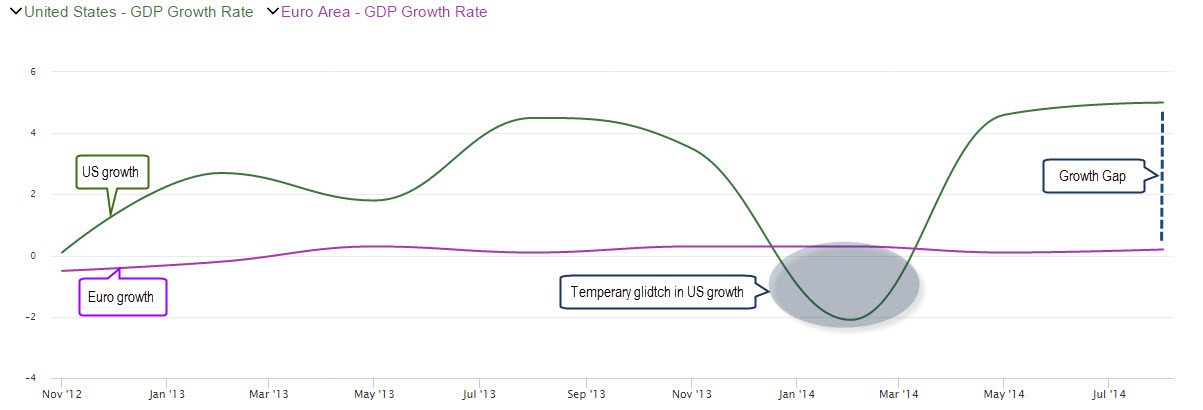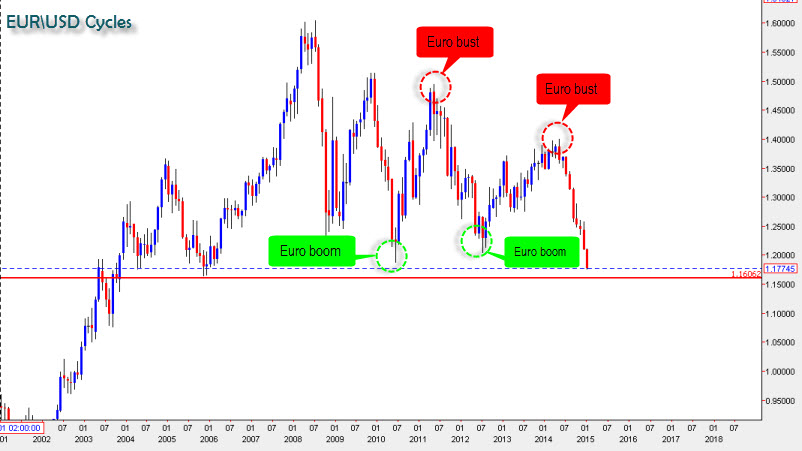
This week, investors believe that they may have finally gotten the green light for ECB easing. With Eurozone inflation officially turning to deflation, investors believe that Mario Draghi and the ECB have been backed up into a corner with no escape, thus they will be forced to initiate a Quantitative Easing program that will balloon its balance sheet. In fact, the buildup towards this move started a few months back with Mario Draghi sending ever clearer signals of the ECB’s intent toward a full blown QE that will probably involve purchases of government bonds in a Federal Reserve-like manner.
If you will recall, Mario Draghi had also outlined the ECB’s intent to balloon its balance sheet back to its 2012 record of roughly €3.1 trillion. With the ECB’s current balance sheet at €2.216 trillion that means an estimated €884 billion in additional liquidity coming to the markets. As would be expected, the Euro has been in utter meltdown over the past few months, sliding to a low not seen in more than 9 years; of course, all this comes on the back of the impending liquidity injection and especially now as deflationary fears were confirmed with the Eurozone’s CPI at -0.2%. So far, this is par for the course, yet for me, this dredges up old memories of 2012.
The Big Mistake
Just by stating the obvious, that the ECB has to increase its balance sheet by a jaw-dropping €884 billion in order to increase its balance to the size it was a little more than two years ago, shows just how big a mistake the ECB has made in its policy since then. Across the “pond,” the Federal Reserve’s balance sheet has been growing since 2012 and its size has only now stabilized, as the US enjoys above-trend growth, a hair’s breadth of full employment and core inflation at a decent 1.7%. In the meanwhile, as the ECB was aggressively shrinking its own balance sheet, Eurozone growth came to a virtual standstill, unemployment remained stubbornly high, exports slowed, manufacturing weakened and, of course, the Eurozone moved into deflation.
From the chart below, comparing the growth rates in the US and the Eurozone, it becomes clear how devastating this move was; while US growth accelerated, Eurozone growth collapsed. Without mincing words; the chart illustrates that the ECB was patently wrong in shrinking back its balance sheet so fast and is, for all intents and purposes, responsible for the Eurozone’s economic crisis.

Image Courtesy of Trading Economics
The Bust and Boom Cycle
Basically, this creates a very vicious cycle for the Eurozone and, of course, the Euro. ECB stimulus balloons its balance sheet, the Euro is devalued and exports gradually begin to recover and pull growth back up and after the bust comes a boom, or perhaps more aptly, a recovery. But therein lies the catch; once the Eurozone recovers, the ECB – by its nature a very conservative entity (rooted by its strongest member, the German Bundesbank) – begins to fret over inflation and that always seems to lead to premature tightening and, as a result, the inception of yet another bust.
The Euro Cycle
Because of the strong link between the Euro and European growth and inflation levels and because growth tends to recover whenever the Euro is low it means that those monetary cycles are reflected in the EUR/USD rate. Every time the Euro is low, growth recovers and the ECB begins to narrow its stimulus, then the Euro gradually rises until exports stumble, deflation comes back and bets of another ECB stimulus push it down once again. It happened in 2011 when the Euro reached €1.5 and it happened last year when the Euro reached 1.4. Now, however, we come to the real test of the Euro; a delicate juncture between another potential boom cycle and a possibly prolonged bust cycle. If the Mario Draghi and the ECB can learn from the past and this time, as the Federal Reserve did, maintain a big balance sheet for a prolonged period then the boom and bust cycle could be over and the Euro could break the 1.16 threshold and begin a much broader sell off wave. The question is will Draghi learn from the past? Time will tell, but a break of the 1.16 could signal that the market movers believe that, this time, ECB stimulus is here to stay and with it a falling Euro.

Image courtesy of Netdania.com
Look for my post next week.
Best,
Lior Alkalay
INO.com Contributor - Forex
Disclosure: This article is the opinion of the contributor themselves. The above is a matter of opinion provided for general information purposes only and is not intended as investment advice. This contributor is not receiving compensation (other than from INO.com) for their opinion.

It's a pity that people like you writing articles than thousands read don' t understand the differences between Europe and the rest of the world.
Europe is a federation of nations sharing common purposes taut are over the pure national interests, USA, Japan, Korea, China , Canada. Are nations acting on their own interests and problems.
In addition to that Europe is the origin of all the ideas that make World today, you name it, Capitalism, socialism, communism, anarchism, republic, democracy.....Europe creates the structures that rest of the world will adopt later.
So don't criticize so lightly European policies because after all we are immersed in the biggest social experiment in the history of the world, we are taking paths of problem solving never attempted in human history.
Now, about economy , we took a different approach than USA, instead of " kicking the can" so our sons will face the same unsolved problems in 20 years, we in Europe decided the opposite, we decided to reform structures, correct deviations, increase productivity AND THEN to apply monetary measures, and we did our process with the highest € rate in history because U.S was not capable of doing their job as main currency in the world.
Your analysis is just with an Americentric approach, you better try to read a bit of European sourced information to understand why, when and to whom.
Mr. Adwill,
You are required to correct your following sentence.
"Europe is the origin of all the ideas that make World today, you name it, Capitalism, socialism, communism, anarchism, republic, democracy....Capitalism, socialism, communism, anarchism, republic, democracy....
Because Before Europe found even any initial idea for all these, all that were already available in India from ancient time. However, that was in a spread manner, or as a way of routine life, or just as wisdom, So All above were originated by India, and later, in a stage or faze manner, migrated to Europe through Arabian Business Community, known as "AARABS"
At this point, I must accept and agree with your remark like "Europe creates the structures that rest of the world will adopt later." Because Basic idea, Fundamental Principals or overall Concept etc. were exists and also in a practice in India, However that was not named or identified as any specific format alike. Later, for which, Europe had provided specific named or precised structure; Fine-tune all such basic concepts, which were received from India, originally in a different format. Europe had contributed to introduced Final out-put in the Identical Model Formats like Capitalism, socialism, communism etc.
Now something about your “biggest social experiment” actually that was an effort to cocktail Capitalism and socialism, which is near to impossible idea to find in a successes full manner through any kind of practice efforts adopted therefore. I have predicted the same results, as actually pictured today, far ahead of time; When Euro was just at its initial concept stage.
Anyway, wish you all the best to find the reliable as well applicable solution to get the best possible fortune now on wards.
Raesh Shukla
in final paragraph, you have suggested Mr. Mario Draghi to Learn maintaining big balance sheet, and way therefor. As per my view, your observation will prove as sure shoot formula, just not only for even worst situation, but also to find extension of basic or fundamental problem for much more longer or possibly even for ever lasting time frame.
We must understand that to maintain or gallop boom and bust cycle through initiating a Quantitative Easing program and ballooning economy. Federal Reserve playing this game since long back, but it is just like a Drug, which is more dangerous then dices.
If you want to know why? and how? you yourself can batter judge this, so, simply consider the cost and future consequences of source of funds, which is essential for adopting such Quantitative Easing programs. Also try to get answer for How long it can be possible to maintain?, and will be next thereafter?.
By way of following such short term measures, problems can be solve for short while, or may get extended, however, we are bound to reimburse cost even with an amount of penalties added therein. There is no free lunch, and each and every thing has it own price tag.